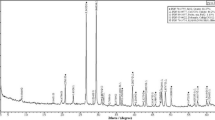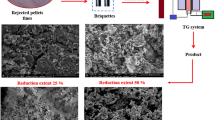Abstract
In tile manufacturing alumina acts as an opacifier in porcelain tile bodies and as a matting agent in glazes. Calcined alumina is a versatile and a new material for glaze industry due to it’s the densest and more stable crystalline form of alumina. The study was accented on examining of the effect of alumina characteristics and concentration on thermal behavior, phase evolution and optical properties of wall tile glazes. For this purpose several wall tile glazes which contain different phases of alumina and a different concentration were prepared and fired in industrial firing cycle. In the study it was showed that softening and melting temperatures of the wall tile glazes were increased with the increment of the alumina concentration. The crystal phases were detected as anorthite, corundum and gahnite. Depending on the forming of new crystalline phases, glazes with different aesthetic properties were obtained in the study.
Similar content being viewed by others
References
Reinosa, J.J., Rubio-Marcos, F., Solera, E., Bengochea, M.A., and Fernandez, J.F., Sintering behaviour of nanostructured glass-ceramic glazes, Ceram. Int., 2010, vol. 36, pp. 1845–1850.
Mimaroğlu, A. and Okumuş, S.C., Friction and wear of hot pressed silicon nitride and aluminum ceramic, TÜBĪ TAK J. Eng. Environ. Sci., 1995, vol. 19, pp. 279–284 [in Turkish].
Bou, E., Garcia-Ten, J., Perez, R., Arrufat, S., and Atichian, G., Influence of alumina characteristics on glaze properties, Bol. Soc. Esp. Ceram., 2010, vol. 49, pp. 271–278.
Minssen, K., Ceramic glaze materials: the top ten list, Ceram. Eng. Sci. Proc., 1997, vol. 18, pp. 308–319.
Eppler, R.A., Controlling glaze surface effects, Adv. Sci. Technol., 2003, vol. 34, pp. 43–54.
Campa, F., Gines, F., and Robles, J., Matting of a transparent porous wall tile glaze by adding alumina, in Proc. World Congress on Ceramic Tile Quality, Qualicer, 2000, vol. 1, pp.15–17.
Sanchez, M.L., Cabrera, M.J., Foo, A., Beltran, H., and Carola, J.B., Transparent glazes for porcelain tile: glassy and glass-ceramic glazes with cristobalite crystallizations, in Proc. World Congress on Ceramic Tile Quality, Qualicer, 2002, pp. 239–254.
http://digitalfire.com/4sight/material/calcined_alumina_41.html
Sorlí, S., Tena, M.A., Mestre, A., Llusar, M., and Monrós, G., Effect of the major devitrifying phase on ceramic glaze microstructure and mechanical properties, in Proc. World Congress on Ceramic Tile Quality, Qualicer, 2004, pp. 99–110.
Author information
Authors and Affiliations
Corresponding author
Additional information
The article is published in the original.
Rights and permissions
About this article
Cite this article
Ozturk, Z.B., Yildiz, B. Effect of alumina characteristics and concentration on thermal behavior, phase evolution, and aesthetic properties of tile glaze coatings. Glass Phys Chem 42, 257–262 (2016). https://doi.org/10.1134/S1087659616030196
Received:
Published:
Issue Date:
DOI: https://doi.org/10.1134/S1087659616030196




